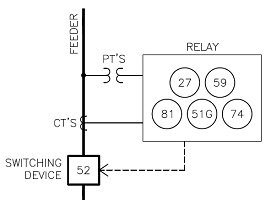IEEE Standards for Protection Relays are essential for ensuring reliable and effective operation of protective relays in electrical power systems. These standards provide comprehensive guidelines that ensure power systems are safeguarded from faults and abnormal conditions.
Overview of Key IEEE Standards
The IEEE has developed a series of standards that cover different aspects of protection relays:
IEEE C37.2: Defines electrical power system device function numbers, acronyms, and contact designations.

IEEE C37.90: Specifies standard service conditions, ratings, and testing requirements for relays and relay systems.

IEEE C37.112: Defines inverse-time characteristics equations for overcurrent relays.

IEEE C37.113: Provides guidelines for protective relay applications to transmission lines.

Example: Protection Scheme for a 138 kV Transmission Line
To demonstrate how IEEE standards guide relay protection, let’s consider a 138 kV transmission line where we aim to implement distance protection for precise fault detection and isolation. Using IEEE C37.113, we can create an effective protection strategy:

Calculate Zone Settings:
- The distance relay settings are segmented into multiple zones to ensure staged fault detection. For example:
- Zone 1 (80% of the line) for immediate tripping.
- Zone 2 (covering the entire line + backup for adjacent lines) for delayed tripping.
- Determine the impedance settings for each zone based on line parameters, ensuring accurate fault localization.
- The distance relay settings are segmented into multiple zones to ensure staged fault detection. For example:
Coordination with Adjacent Relays:
- Set time delays to coordinate with downstream and upstream relays, ensuring proper fault isolation and minimizing unnecessary outages.
- Utilize reach multipliers and adjust timing for selective tripping between primary and backup relays.
Adaptive Settings Based on Load Conditions:
- Implement adaptive relay settings to account for seasonal load variations. Use data from the relay’s monitoring system to adjust the reach values dynamically, enhancing fault detection accuracy under changing load conditions.
Fault Analysis and Testing:
- Using IEEE C37.90, conduct relay testing under simulated fault conditions to validate the settings.
- Include scenario-based testing, such as high impedance faults or multi-phase faults, to ensure the relay’s ability to handle diverse conditions.
Why IEEE Standards Matter for Relay Engineers
Relay protection engineers rely on these standards to ensure the design, application, and testing of relays adhere to industry best practices. Properly designed protection relays help maintain grid stability, minimize downtime, and protect critical infrastructure.
Challenges and Best Practices
While IEEE standards provide comprehensive guidelines, real-world applications may require adjustments based on specific grid conditions. Considerations like data accuracy, fault coverage, and coordination with other devices are essential for successful implementation.
Conclusion
IEEE Standards for Protection Relays provide essential guidelines for engineers, ensuring reliable and coordinated protection schemes in electrical power systems. Adherence to these standards results in enhanced system stability, optimized protection, and greater overall reliability.
For more detailed information, you can explore the standards directly from IEEE.
